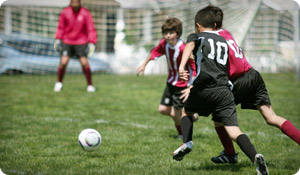
Each year, more than 3.5 million children experience sports-related injuries, according to the American Academy of Pediatrics (AAP). While some of these do require medical care, you can often treat simple strains and sprains yourself in the comfort of your home, as long as you've ruled out a broken bone.
Kids and Injuries
If your child plays competitive sports and trains too hard, the risk of suffering a strain or sprain can be high. But your youngster doesn't have to be an athlete to get hurt. Injuries can happen anywhere, anytime. Therefore, it's important to know the basics of how to treat common ailments.
Sprains and Strains
Muscle strains and ligament sprains are two of the most common injuries that affect children today and the good news is that most of the time these heal on their own. But there are things you can do to speed up the process and also make your child more comfortable.
- A strain is when your child's muscle (such as the back, legs, and even neck) is stretched further than it's intended. This occurs when your child hasn't warmed up enough before exercising or engaging in strenuous activity.
- A sprain occurs when the ligaments that hold the bones together at the joints does a similar over-stretching. This affects knees, wrists, and ankles and usually is caused by a specific injury.
While both strains and sprains can be very painful, you usually won't see any visible effects of a strain. On the other hand, a sprain can look bruised and swollen and can be difficult to move.
The Danger with Sprains
Many sprains can mimic the signs of a broken bone, so when it doubt, bring your child to the pediatrician or local emergency room to rule out a serious injury. An x-ray may be needed to differentiate.
How to RICE
Once you've confirmed that your child's injury is a basic strain or sprain, doctors recommend following the acronym RICE, which includes these four key steps:
- Rest: Keep your child from using the injured area. This protects the area from further injury and allows the body to focus on healing.
- Ice: Apply ice or cold compresses for 15 to 20 minutes at a time to limit blood flow to the injury and reduce swelling, which ultimately helps it heal.
- Compression: Wrap the injured area with an elastic bandage or splint to keep swelling down and relieve pain.
- Elevation: Prop up the injured limb so that it's higher than the heart. This prevents too much blood from going to the injury and keeps swelling to a minimum.
Repeat these steps as needed for the first 24 to 48 hours after a strain or sprain occurs. For more severe injuries or when your child has serious discomfort, your pediatrician may recommend also using a pain reliever.
What to Expect
A strain can last as long as a week, while a sprain can linger for up to a month. It's important to limit your child's activity during the healing process, in order to prevent making it worse or experiencing other injuries.
Sources:
American Academy of Pediatrics (AAP)/HealthKids.org
http://www.healthychildren.org
http://www.aap.org/advocacy/releases/sportsinjury.htm
Pediatrics
http://pediatrics.aappublications.org/cgi/content/abstract/116/1/96
National Institute of Arthritis and Musculoskeletal and Skin Diseases
http://www.niams.nih.gov/Health_Info/Sports_Injuries/child_sports_injuries.asp





